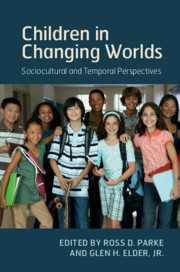Book contents
- Children in Changing Worlds
- Children in Changing Worlds
- Copyright page
- Contents
- List of Figures
- Contributor Biographies
- Preface
- Part I Theoretical and Methodological Approaches: A Cross-Disciplinary Challenge
- Part II Historical and Life Course Transitions: Economic and Demographic Change
- Part III Social, Legal, and Technological Change: Impact on Children
- 7 The Urban World of Minority and Majority Children
- 8 Changing Family Forms: The Implications for Children’s Development
- 9 Communication Technologies and Social Transformation: Their Impact on Human Development
- Part IV Views of the Interdisciplinary Dialogue: From Developmental Science and Sociology
- Author Index
- Subject Index
- References
8 - Changing Family Forms: The Implications for Children’s Development
from Part III - Social, Legal, and Technological Change: Impact on Children
Published online by Cambridge University Press: 18 July 2019
- Children in Changing Worlds
- Children in Changing Worlds
- Copyright page
- Contents
- List of Figures
- Contributor Biographies
- Preface
- Part I Theoretical and Methodological Approaches: A Cross-Disciplinary Challenge
- Part II Historical and Life Course Transitions: Economic and Demographic Change
- Part III Social, Legal, and Technological Change: Impact on Children
- 7 The Urban World of Minority and Majority Children
- 8 Changing Family Forms: The Implications for Children’s Development
- 9 Communication Technologies and Social Transformation: Their Impact on Human Development
- Part IV Views of the Interdisciplinary Dialogue: From Developmental Science and Sociology
- Author Index
- Subject Index
- References
Summary
The proliferation of a wide variety of family forms has challenged the centrality and necessity of the traditional nuclear family as a context for successful socialization. Views of the importance of the gender of parents, sexual orientation of parents, biological relatedness of family members, and new routes to parenthood are challenged. Increases in divorce, the rise in the number of stepfamilies, cohabitating couples, single parents, and adoption raise further questions about the links between both the number of parents and the biological ties among family members. The gender, sexual orientation, or biological relatedness of the agent of delivery of the critical ingredients for socialization (i.e., stimulation, nurturance ,guidance, limit setting) or the family form in which these processes are enacted are less important than the processes themselves. Second, an interdependent model of family functioning is proposed, which reflects the increasing degree of outsourcing of tasks and responsibilities. To maximize assistance available to a full range of family forms, it is critical that policy makers recognize the diversity of family forms and develop suitable policies.
Keywords
- Type
- Chapter
- Information
- Children in Changing WorldsSociocultural and Temporal Perspectives, pp. 192 - 234Publisher: Cambridge University PressPrint publication year: 2019
References
- 1
- Cited by

